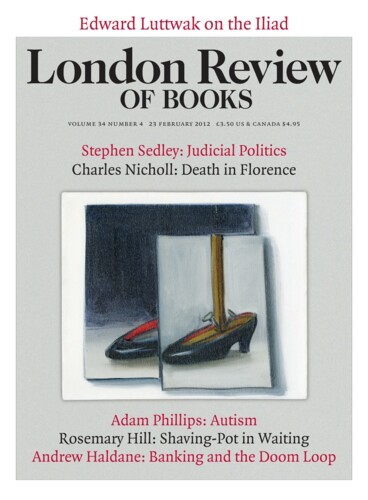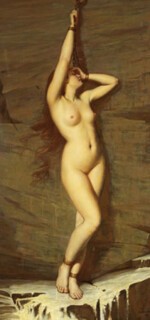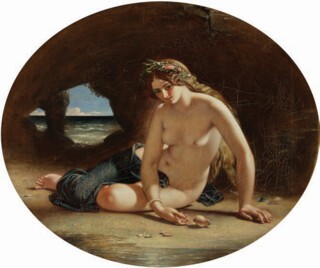What is the difference between great art and tat? In the theatre, Dr Johnson’s rule of thumb seems adequate: if people are still prepared to revive a play a century after its premiere, it probably matters, whether or not they call it ‘dramatic art’. But it’s trickier with paintings, which have a relationship to the word ‘art’ that baffled me for years. When I was a child, there was ‘art’ and then there were pictures, and the latter were to be preferred. Art turned up in Look and Learn, World of Wonder and a board game called Masterpiece, and it was small, blurred and usually incomprehensible, even when Kenneth Clark was standing in front of it sounding enthusiastic on television. Why was a naked man wrapped in a curtain jumping over a wagon from behind a tree, twisting his head oddly as he did so to look towards a girl who seemed to be pushing an imaginary door in an unnaturally blue sky? And what were leopards doing there? Why was the Virgin Mary, among some equally blue angels in the right-hand panel of an unattractively hinged double set, trying to throw the baby Jesus across the intervening frame at the kneeling king on the left? And why was I supposed to care about the mustard-coloured pot on the mustard-coloured table with the mustard-coloured dead sunflowers in it?
Pictures were another matter. You could imagine living with pictures; my parents’ house had pictures and so did the houses of my schoolfriends’ parents. They were all reproductions – there was a reasonable selection upstairs in the Bournemouth branch of Boots – but the important thing was that you could see what they were about. Nice views, appealing animals, snow scenes, the occasional young woman in varying quantities of folksy clothes: you knew where you were with pictures.
Confusingly, though, the one public building in Bournemouth you might visit in order to see what definitely seemed to be pictures purported to be a repository of the other stuff. This was a building called the Russell-Cotes Art Gallery and Museum, but since it clearly wasn’t really a museum – it was quite unlike the nearby Rothesay Museum, with its dreary glass cases of geological samples, pot shards and flint arrowheads – perhaps its claim to be an art gallery didn’t have to be taken literally either.
It had originally been the house of Sir Merton Russell-Cotes (1835-1921). East Cliff Hall, completed in 1901, was a peculiar but attractive compound of Scots baronial castle, Italian villa, French château and seaside folly, standing in a prime position looking over Bournemouth Bay. It doesn’t match its neighbour, the conventionally neo-Georgian whitewashed stucco of the Royal Bath Hotel, which Russell-Cotes managed and he had ornamented with a miscellaneous and ever growing collection of paintings. ‘You have built and fitted up, with the greatest beauty and elegance, a palace,’ one satisfied guest, Oscar Wilde, said, ‘and fitted it with gems of art, for the use and benefit of the public, at hotel prices.’
Perhaps stung by this last clause, Russell-Cotes’s second palace, East Cliff Hall, was wholly uncommercial. It was presented first as a gift to his wife, Annie, and ultimately, complete with an extension to allow more of their collection to be displayed at any one time, as their joint bequest to the citizens of Bournemouth. During their years in the house, Sir Merton and Annie, with all the energetic acquisitiveness of their class and generation, filled East Cliff Hall not only with the pictures and statues which had graced the Royal Bath, but with an extraordinary assemblage of sheer stuff: souvenirs from exotic holidays, mementoes from Russell-Cotes’s years as the town’s mayor, impulse purchases at auctions, and even more pictures, including a commanding official portrait of Russell-Cotes himself, his florid complexion perfectly matching the scarlet of his mayoral robes.
My childhood memories of the place, to which I must have been taken by my parents, are of a nightmarish clutter of bibelots and trophies, many of them draped in dustsheets. Even in the dim light produced by the permanently drawn blinds I was dazzled by the gold pseudo-Byzantine mosaics and the fountain in the hall, the Moorish alcove upstairs and the burnished peacocks displaying themselves around the dining room walls, but their faded glories were upstaged by the card table said to have belonged to Napoleon, the samurai armour bought in Japan soon after it first opened for tourist business, the cases and cases of miniatures and mourning brooches. Russell-Cotes might have intended his show-house to become a museum of high culture, but by the 1960s it just seemed the grandest of the many Victorian houses in Bournemouth where someone had died, and no one had known what to do with all their possessions.
As for the pictures, which covered almost every available square foot of wall, did they have to be thought of as art simply because they weren’t reproductions? By the time I was wondering about this, I was a teenager, and a willingness to make a detour to the Russell-Cotes instead of just sloping around the shops and cafés on a Saturday afternoon constituted an important assertion of intellectual aspiration. Even though I had never knowingly seen any good art, I had certainly picked up the idea that the museum’s contents were to be considered bad art. But it was luridly and sometimes pleasurably bad, a bit like the films of Ken Russell – one of which was partly filmed there. The sort of art collected and displayed by eminently respectable Victorian mayors, bizarrely, turned out to be almost as pornographic as the soi-disant art films sometimes shown late at night on BBC2. Apart from the lovingly depicted pets, children with ponies, sea views and winter landscapes, the pictures on Sir Merton’s walls were mostly of naked and semi-naked young women: topless Babylonian slave girls in the proto-Cinemascope scenes from the Old Testament filled the extension and blushing, dangling Andromedas, both painted and sculpted, were in the house proper, handcuffed to rings well above and behind their heads to make sure the sea monster could get a proper look at its promised meal. In the world of late 19th-century academic art, it turned out, you only had to call a picture Bathing Diana or Nymph at Play and you could do what you liked with the model. A friend and I tried surreptitiously to count all the female nipples on public display in the gallery: the number came to at least twice the number of canvases and statues.
Then I left Bournemouth to go to university, and I got to know London, and I read Peter Conrad’s The Victorian Treasure-House and, belatedly, Tess of the D’Urbervilles, with its glimpses of the nouveau riche glamour Bournemouth (a.k.a. Sandbourne) had briefly enjoyed before settling down to become the place I knew only as an embarrassing retirement destination. And through visiting art galleries and having a girlfriend who knew and cared about the fine arts, I got to know something about the history of painting. Disappointingly, the English 19th century after Turner seemed to be beneath the girlfriend’s notice, and when we walked around the Russell-Cotes one vacation, I found myself beginning to feel uncomfortable with the derision she clearly felt for most of what was in the museum, however snide I had been about it myself. For one thing, I had come to share Annie and Sir Merton’s interest in 19th-century theatre, and had grown attached to the Henry Irving Room – the guest bedroom in which the actor had stayed for a weekend, subsequently turned into a shrine, full of relics bought at auction after his death – and had also noticed that some of the theatrical portraits the Russell-Coteses had collected, such as James Archer’s Henry Irving as Charles I (1873) and John Collier’s Lewis Waller as Monsieur Beaucaire (1903), were really very fine.
I had also begun to feel defensive about genre painting, which seemed to be eminently respectable when executed by 17th-century Dutchmen but was otherwise bafflingly taboo. Was it really so ludicrous that Bournemouth’s only art gallery should be dominated by representational art of the sort its citizens had in their living rooms? And was there really a difference in kind between the Russell-Cotes Museum and the Wallace Collection, other than the fact that Hertford House and all those Fragonards and Watteaus had cost a great deal more than East Cliff Hall with its Landseers and Edwin Longs? And what about Titian’s Perseus and Andromeda in the Wallace – doesn’t it escape being kitsch only because it’s 16th century, unlike Arthur Hill’s Captive Andromeda? At least Hill’s painting admitted that the whole point was the nude in bondage in the foreground, and didn’t add a ludicrously inverted flying Perseus and a monster out of a Chinese carnival.
By the time I started taking my children to visit their grandparents the Russell-Cotes had been spruced up with lottery money and supplied with another extension, which enabled the collections to be displayed without the old sense of impossible debris; soon there would even be a proper book about them – A Victorian Salon by Simon Olding, Giles Waterfield and Mark Bills. By then Art Nouveau had quietly come back into fashion, and the house and its contents looked less comically dead than I’d remembered them. My daughters, entranced by the fountain and the pictures of ponies, announced that they wanted to live there when they grew up, something they’d never said about the Art Institute of Chicago. Still there, and properly lit at last, were the paintings I had known all my life: from Frederick Pickersgill’s The Sirens (three young women, three nipples visible), to Edwin Long’s The Chosen Five: Incident in the Life of Zeuxis (five young women, five nipples), and that notable work by Briton Rivière RA, Tick-tick (a winsome pug looking disconcertedly at a pocket watch, no nipples). I was positively worried at how delighted I was to see these canvases again. Had I still not outgrown the provincial sensibility of Sir Merton Russell-Cotes, or at least the guiltily snobbish enjoyment in half-ridiculing it?
I shelved this worry until I found myself again spending time in the Russell-Cotes a couple of years ago. I took refuge there while nurses fed my father in the home where he was dying, a few streets away. Was it art, and did it matter? It was at least still here. Sitting in front of William Edward Frost’s The Sea Cave (one sea nymph, two nipples), I wondered whether I was alone in finding it hard to distinguish between the pleasures of the purely aesthetic and the pleasures of kitsch. In the 21st century, doesn’t every idea of beauty seem just as touchingly passé as the one enshrined at the Russell-Cotes?
Send Letters To:
The Editor
London Review of Books,
28 Little Russell Street
London, WC1A 2HN
letters@lrb.co.uk
Please include name, address, and a telephone number.



